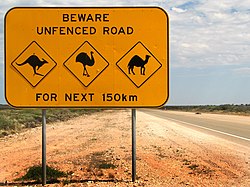Roadkill
Roadkill is any animal that has died on a road because it was hit by a vehicle, for example a deer hit by a car. Vehicles pulled by animals, for example mule carts, did make roadkill, but there was much more roadkill after the invention of the automobile.[1]
In the United States alone, one to two million large animals are killed as roadkill every year and many more small animals.[2]
Causes and costs
Most roadkill is caused by cars or trucks.
If the car hits a large animal, for example a deer or elk, it is likely to be damaged. In the United States alone, crashes with deer cause $3.6 billion in damage to cars and other vehicles, 200 deaths each year and many injuries.[2]
Uses
Some roadkilled animals are sent to landfills with other garbage, but other bodies are used for scientific experiments, turned into makeup or turned into food for other animals. Some people cook and eat roadkill. Other people make the fur into clothes or other useful things.[3] Some scientists have studied roadkill to see where invasive species have come.[1]
In Alaska, all roadkill belongs to the state. Officers collect the roadkill, bring it to butchers, and bring the meat to charities. In other parts of the United States and in other countries, individual people can get permission to collect roadkill in different ways.[4][5]
Preventing roadkill
Many governments put up road signs such as "deer crossing" or "panther crossing" signs to tell drivers that there may be animals nearby. Some build fences around roads where cars drive at high speeds. However, then the animals try to cross at the ends of the fences, and they are hit by cars in those places.[2]
Planning new roads so that wild animals can go over or under them from the start is another very good way to prevent roadkill.[2]
Some governments have built wildlife bridges over or underpasses under roads that were already there. In 2009, the local Department of Transportation built fences leading to four culverts on U.S. highway 27, and there were suddenly no roadkilled turtles.[2]
Roadkill Media
The battered remains of a roadkilled deer on South Carolina Highway 170 by the Chechessee River in South Carolina, US
Wide-ranging large carnivores like this bear are particularly vulnerable to becoming roadkill.
Roadkill caracal in Afedena (exclosure), Ethiopia
Mountain goats used to cross US Route 2 to reach a salt lick on the other side of the canyon. Now they can get there via rocky passageways underneath these bridges, shielded from view by tree cover and the steep hillside.
Traffic signs are often used to warn of areas with increased animal activity. These signs are not always successful, as shown by the dead emu in the far distance to the right of the sign.
Moose crossing sign with kill counter, Kenai, Alaska. Trees and brush near the road are trimmed back to make approaching moose easier to see.
Lion-tailed macaque (Macaca silenus) on the canopy bridge in Annamalai Hills
References
- ↑ 1.0 1.1 Joseph Stromberg (March 23, 2015). 6 things scientists have learned from studying roadkill. Vox. https://www.vox.com/2015/3/23/8266571/roadkill-science. Retrieved September 14, 2020.
- ↑ 2.0 2.1 2.2 2.3 2.4 Melissa Gaskill (May 16, 2013). Rise in Roadkill Requires New Solutions. Scientific American. https://www.scientificamerican.com/article/roadkill-endangers-endangered-wildlife/. Retrieved September 16, 2020.
- ↑ David Wilson (April 27, 2019). Roadkill: What happens to animals that die on our roads?. BBC. https://www.bbc.com/news/uk-northern-ireland-foyle-west-47884992. Retrieved September 14, 2020.
- ↑ Amy Halloran (April 18, 2011). Wild and Free, But Is Roadkill Safe to Eat?. Food Safety News. https://www.foodsafetynews.com/2011/04/roadkill-and-food-safety/. Retrieved September 14, 2020.
- ↑ Poppy Noor (October 19, 2019). How to eat roadkill: everything you need to know. Guardian. https://www.theguardian.com/world/2019/oct/15/how-to-eat-roadkill-everything-you-need-to-know. Retrieved September 14, 2020.












